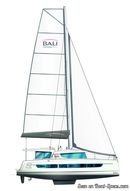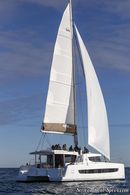Bali 4.8
Sailboat specifications
The Bali 4.8 is a 46’11” (14.28m) cruising catamaran designed by Xavier Faÿ (France). She is built since 2020 by Catana (France).
Bali 4.8's main features
- Model
- Bali 4.8
- Hull type
- Catamaran
- Category
- Cruising catamaran
- Sailboat builder
- Sailboat designer
- Sailboat range
- Country
- France
- Construction
- GRP (glass reinforced polyester):
Sandwich PVC fiberglass polyester (vacuum infusion) - First built hull
- 2020
- Last built hull
- Still in production
- Appendages
- Skegs : skeg on each hull
- Helm
- Single helm wheel
- Rudder
- Twin spade rudders
- Unsinkable
- No
- Trailerable
- No
- EC design categoryiThe CE design category indicates the ability to cope with certain weather conditions (the sailboat is designed for these conditions)
A: Wind < force 9, Waves < 10m
B: Wind < force 8, Waves < 8m
C: Wind < force 6, Waves < 4m
D: Wind < force 4, Waves < 0,5m - A
- Standard public price ex. VAT (indicative only)
- About575 000 €(2020)
Bali 4.8's main dimensions
- Overall length
- 48’ 10”14.86 m
- Hull length
- 46’ 11”14.28 m
- Waterline length
- 46’ 1”14.06 m
- Beam (width)
- 25’ 11”7.88 m
- Draft
- 4’ 5”1.35 m
- Mast height from DWL
- 75’ 10”23.11 m
- Light displacement (MLC)
- 33731 lb15300 kg
- Maximum displacement (MLDC)
- 48502 lb22000 kg
Bali 4.8's rig and sails
- Upwind sail area
- 1378 ft²128 m²
- Downwind sail area
- 1841 ft²171 m²
- Mainsail area
- 872 ft²81 m²
- Solent area
- 506 ft²47 m²
- Code 0 area
- 969 ft²90 m²
- Rigging type
- Sloop Marconi (square top mainsail) fractional
- Mast configuration
- Deck stepped mast
- Rotating spars
- No
- Number of levels of spreaders
- 1
- Spreaders angle
- Swept-back (diamond)
- Spars construction
- Aluminum spars
- Standing rigging
- 1x19 strand wire discontinuous
Bali 4.8's performances
- Upwind sail area to displacementiThe ratio sail area to displacement is obtained by dividing the sail area by the boat's displaced volume to the power two-thirds.
The ratio sail area to displacement can be used to compare the relative sail plan of different sailboats no matter what their size.
Upwind: under 18 the ratio indicates a cruise oriented sailboat with limited performances especially in light wind, while over 25 it indicates a fast sailboat. - 224 ft²/T20.77 m²/T
- Downwind sail area to displacementiThe ratio sail area to displacement is obtained by dividing the sail area by the boat's displaced volume to the power two-thirds.
The ratio sail area to displacement can be used to compare the relative sail plan of different sailboats no matter what their size. - 299 ft²/T27.75 m²/T
- Displacement-length ratio (DLR)iThe Displacement Length Ratio (DLR) is a figure that points out the boat's weight compared to its waterline length. The DLR is obtained by dividing the boat's displacement in tons by the cube of one one-hundredth of the waterline length (in feet).
The DLR can be used to compare the relative mass of different sailboats no matter what their length:
a DLR less than 180 is indicative of a really light sailboat (race boat made for planning), while a DLR greater than 300 is indicative of a heavy cruising sailboat. - 156
Bali 4.8's auxiliary engine
- Engine(s)
- 2 inboard engines
- Engine(s) power (min./max.)
- 45 HP / 57 HP
- Fuel type
- Diesel
- Fuel tank capacity
- 264.2 gal1000 liters
Bali 4.8's accommodations and layout
- Cockpit
- Aft cockpit, front cockpit and flybridge
- Cabin(s) (min./max.)
- 3 / 7
- Berth(s) (min./max.)
- 6 / 13
- Head(s) (min./max.)
- 4 / 6
- Freshwater tank capacity
- 264.2 gal1000 liters
- Holding tank capacity
- 58.1 gal220 liters
- Fridge/ice-box capacity
- 162.5 gal615 liters
- Boiler capacity
- 31.7 gal120 liters


















Catana Bali 4.8 interior and accommodations - - 17/21
Picture extracted from the commercial documentation © Catana
Picture extracted from the commercial documentation © Catana


Catana Bali 4.8 interior and accommodations - - 18/21
Picture extracted from the commercial documentation © Catana
Picture extracted from the commercial documentation © Catana


Catana Bali 4.8 interior and accommodations - - 19/21
Picture extracted from the commercial documentation © Catana
Picture extracted from the commercial documentation © Catana


Catana Bali 4.8 interior and accommodations - - 20/21
Picture extracted from the commercial documentation © Catana
Picture extracted from the commercial documentation © Catana


Catana Bali 4.8 interior and accommodations - - 21/21
Picture extracted from the commercial documentation © Catana
Picture extracted from the commercial documentation © Catana
Similar sailboats that may interest you:
Sailboats
First built hull
Hull length
2010
45’ 10”13.96 m
2005
51’15.54 m
2012
52’15.84 m
2010
45’ 10”13.96 m
2016
42’12.8 m
2016
43’ 7”13.3 m
2017
48’ 5”14.75 m
2018
41’ 4”12.58 m
2017
45’13.72 m
2019
50’ 6”15.4 m
2019
50’ 6”15.4 m
2017
45’13.72 m
2018
53’ 1”16.2 m
2018
41’ 7”12.69 m
2009
39’ 4”11.97 m